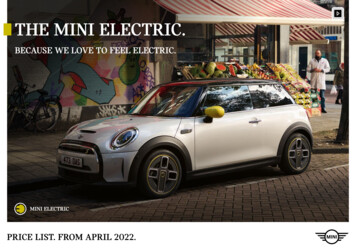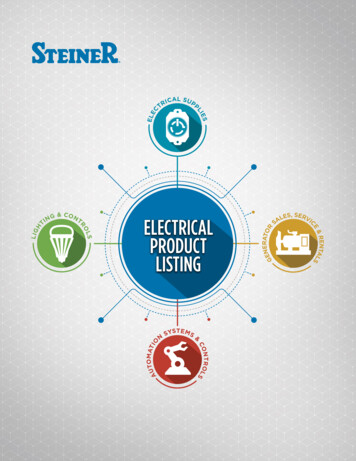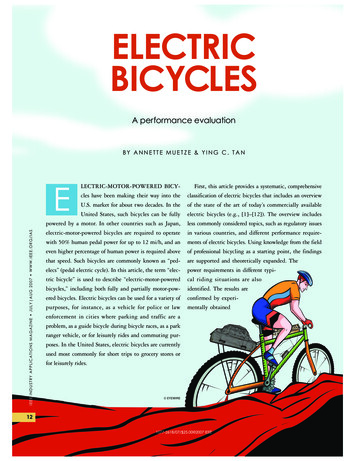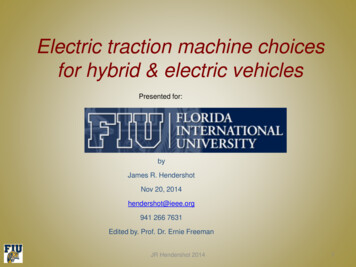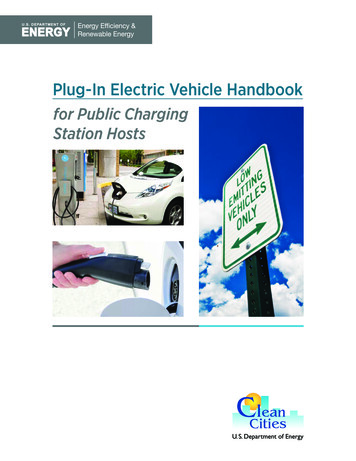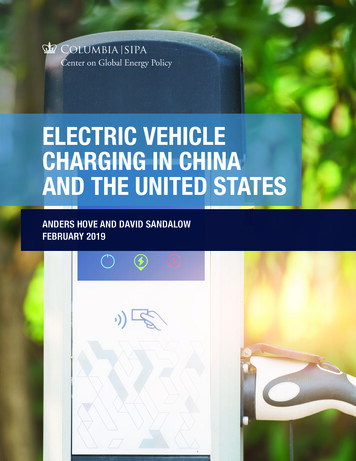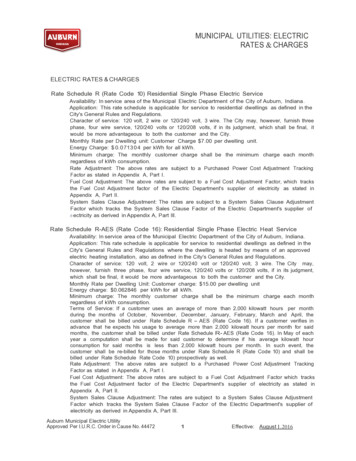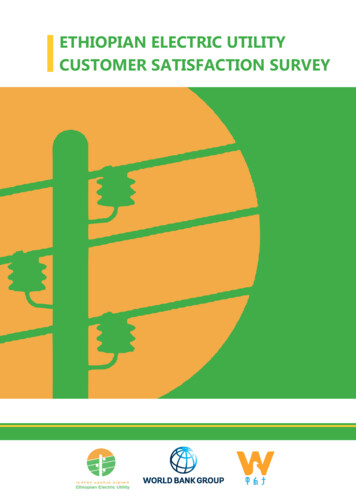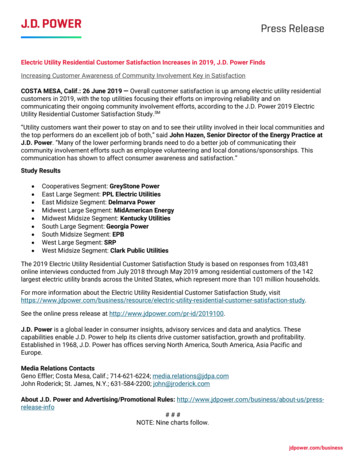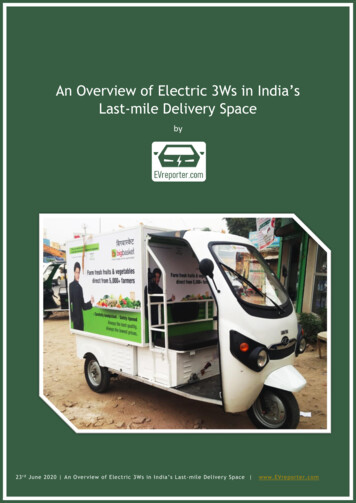
Transcription
An Overview of Electric 3Ws in India’sLast-mile Delivery Spaceby23 r d June 2020 An Overview of Electric 3Ws in India’s Last -mile Delivery Space www.EVreporter.com
Contents1.Introduction. 32. Drivers for the rise of EVs in last-mile logistics . 42.1 Parity in the total cost of ownership. 42.2 Corporate commitments to sustainability . 52.3 Emergence of EV logistics players . 62.4 Policy support . 73. Categorization of electric 3Ws in cargo applications . 94. Trends in electric cargo space . 104.1 Moving from L3 to L5 category vehicles . 104.2 Complete shift to Lithium-ion battery chemistry . 104.3 Localisation . 114.4 Battery Swapping . 114.5 Use of Data and Telematics . 125. Challenges associated with electric fleet operations . 135.1 High upfront cost coupled with financing challenges . 135.1.1 Q&A with Rajeev YSR - COO, Avaan India . 145.2 Overheads of charging and service infrastructure. 155.3 Absence of equivalent performance electric vehicles . 155.4 Training the driver partners . 156. Popular electric 3W cargo models in L5 Category . 166.1 GMW Taskman SmartAuto . 166.2 Kinetic Safar Star MSV 400 . 176.3 Li-ions Elektrik . 186.4 Vidhyut C1 . 186.5 Omega Seiki Singha Max (to be launched in 2020). 196.6 Altigreen electric 3W L5 Cargo (expected to launch in 2020) . 207. Concluding Thoughts . 218. Annexures . 228.1 Revised Phased Manufacturing Program for xEV parts for eligibility under FAME 2 . 228.2 Performance criteria under FAME 2 for electric 3Ws . 238.3 Segment-wise incentives under FAME 2 for electric 3Ws . 2423 r d June 2020 An Overview of Electric 3Ws in India’s Last -mile Delivery Space www.EVreporter.com2
1.IntroductionThe uptake of electric vehicles (EVs) in Indian personal mobility space remains lowdue to barriers of high acquisition cost, range anxiety and lack of public charginginfrastructure to name a few.Experts agree that EV adoption makes better financial sense for B2B services andcommercial applications where some of these barriers can be circumvented throughintelligent route planning, installation of captive charging facilities or using batteryswapping services. The parity in Total Cost of Ownership (TCO) with ICE vehicles canbe achieved rather swiftly on account of lower operating expenses entailed by EVsand higher asset utilization in case of commercial applications. Given the nature ofdeliveries around a designated warehouse, last-mile deliveries make an excellent usecase for electric mobility, overcoming the range anxiety.The popularity and prevalence of electric three-wheelers for last-mile logistics is on aconstant rise. This report discovers the drivers for the rise of EVs in intra-city cargospace, talks about the key players manufacturing the vehicles and providing cargofleet services using EVs, operational challenges and current trends in this domain.23 r d June 2020 An Overview of Electric 3Ws in India’s Last -mile Delivery Space www.EVreporter.com3
Drivers for the rise of EVs inlast-mile logistics2.2.1 Parity in the total cost of ownershipElectric 3Ws entail a running cost of 50 to 60 paise per km vis-a-vis more than Rs 3.0per km by their diesel counterparts. Over the life of the asset, this adds up to sizeableoperational savings. The time taken to achieve the parity with ICE counterpartsdepends largely on asset utilization measured in terms of distance covered by thevehicle.Dr Deb Mukherji - MD at Omega Seiki says, “Despite the higher cost of acquisition,durable electric vehicles deliver economic benefit. Our calculations show if you aredoing more than a 100 km a day, the parity with ICE vehicle can be achieved withina year”.“While the monthly EMI on both the vehicle types is almost the same (approximately 10,000 -12,000 per month), the actual savings can be observed in monthlymaintenance and fuel. The daily distance covered for deliveries in the city is typicallybetween 80 to 100 km. It would cost the diesel vehicle driver 400-450/day on fueland EV driver 50-60/day on electricity, “ shares Sri Harsha Bavirisetty, COO atGayam Motor Works.Another operational cost benefit of EVs is that they require less tinkering andmaintenance than ICE vehicles.23 r d June 2020 An Overview of Electric 3Ws in India’s Last -mile Delivery Space www.EVreporter.com4
2.2 Corporate commitments to sustainabilityE-commerce companies and third-party logistics players across the board arecommitting to including electric vehicles in their fleet as a part of their sustainabilityinitiatives.Back in January 2020, Amazon IndiaCase in Pointmade an announcement to include10,000 EVs (both 3Ws and 4Ws) in itsfleet of delivery vehicles by 2025.According to reports, the overall outlayfor this commitment is valued at Rs 250300 crore.Image Source: PACE EV LinkedIn pageIKEA intends to be 100% electric globally in terms of mobility by 2030. TheirHyderabad store was first of its kind to introduce electric vehicles for delivery of smallcargo to customer homes in India.Flipkart has committed to replacing 40% of its delivery fleet with EVs. Companies likeAmazon, BigBasket, Grofers and Swiggy have been using Electric vehicles for homedeliveries for over a year.23 r d June 2020 An Overview of Electric 3Ws in India’s Last -mile Delivery Space www.EVreporter.com5
2.3 Emergence of EV logistics playersThere have emerged specialty players that are using electric vehicles for providinglogistics services to their clients - examples being Euler Motors, DOT, Avaan India,eFleetLogix. These companies are being met with an ample amount of traction andmarket demand from both e-commerce players and conventional third party logistics(3PL) companies. Keeping up with the trend, incumbent logistics players such as GatiKWE, Delhivery, Ecom Express and Shadowfax etc. have all included EVs in theirfleets for last-mile and hyperlocal deliveries.DOT - Gurugam headquartered logisticsCase in Pointcompany DOT runs a fleet of 1000electric 3Ws and 200 electric 2Ws todeliver more than 10,000 packages a dayusing EVs across the country. Counts thelikes of Swiggy, Zomato, Grofers andAmazonFresh among its clients. Claim tobe the first in the country to use the L5electric 3Ws to make deliveries.Euler Motors - Euler Motors recently in news for raising INR 20 crores as a part of SeriesA funding, a total of 4.6M raised so far. The start-up was founded in April 2018 and hascovered 31,25,790 electric km by Jun 2020. The company currently provides last-miledelivery services for the likes of Amazon, Grofers, BigBasket, Udaan and Blue Dart,among others, using its fleet of electric L3 cargo vehicles. Euler Motors is also in theprocess of developing a cargo vehicle in L5 category that will be available for sale oncethe certification process is complete.23 r d June 2020 An Overview of Electric 3Ws in India’s Last -mile Delivery Space www.EVreporter.com6
2.4 Policy supportFAME II incentives have been critical to the rise of organised electric 3Ws by takingthe edge off the high sticker price of 3Ws run on Lithium-ion batteries. For example,Kinetic Green's Shakti Star in L5 category receives a FAME II incentive of INR 59,500brining the cost of acquisition (INR 2,38,000) close to its diesel counterparts that cancost between 1.7 to 2.2 lakhs for similar payload capacity and performance. BS-VI ICEvehicles are expected to cost even more.The price difference between a lead-acid battery e-3W and Lithium-ion e-3W withsimilar configuration can be between INR 45,000 to INR 60,000. However,Government incentive under FAME II is applicable on Lithium-ion battery vehicles.Lithium-ion battery packs present a better proposition given advanced batterychemistry that can charge faster (run more kms per day) and provide a battery lifeof more than 4 years.Central Government’s push towards EV adoption in commercial and pubic transportspace, coupled with state level EV policies proposing incentives for electric 3 wheelershas been instrumental in the rise of EVs in cargo space.Delhi EV Policy 2019 documentexempts the e-carriers from itsprohibition on plying and idleparking of light goods vehicleson identified roads of NationalCapital Territory during specifiedtimings.Case in PointTamil Nadu draft EV policy 2019proposes 100% road taxexemption and no permitrequirement for batteryoperated 3-wheeler goods, ecarriers and electric light goodscarriers.Punjab draft EV policy releasedin Nov 2019 proposed freshpermits only for electric 3Ws inidentified target cities afterpolicy implementation.23 r d June 2020 An Overview of Electric 3Ws in India’s Last -mile Delivery Space www.EVreporter.com7
Such norms are instrumental in lending a competitive edge to electric vehicles vis-avis conventional ICE carriers for cargo applications.Rajeev YSR – COO at Avaan India says, “EVs will have lesser restrictions in terms ofentry into key metro areas compared to the conventional LCVs used in intra-cityoperations. Additionally, urban civic bodies across the country want to promote electricmobility through waivers in entry restrictions and taxation, etc., which means flexibilityand cost efficiencies in deliveries to key urban demand points.”23 r d June 2020 An Overview of Electric 3Ws in India’s Last -mile Delivery Space www.EVreporter.com8
Categorization of electric 3Wsin cargo applications3.There are two categories of electric three-wheelers used in cargo applications, whichare defined as follows:L5N - A three-wheeled motor vehicle with a maximum speed exceeding 25 kmph andmotor power exceeding 0.25 kW. Gross Vehicle Weight (GVW) is limited to 1500 kg(excluding the weight of traction batteries).L3 or e-carts - Speed less than 25km/h and motor power less than 2 kW. Suchvehicles are constructed or adapted for carrying goods by providing a separate loadbody or compartment with the maximum weight 310 kg in addition to driver.Electric 3W for Cargo Applications CategorizationQualification CriteriaL5L3Top Speed 25 km/h25 km/hMotor Power 250 W 2000 W23 r d June 2020 An Overview of Electric 3Ws in India’s Last -mile Delivery Space www.EVreporter.com9
4.Trends in electric cargo space4.1 Moving from L3 to L5 category vehiclesAs it currently stands, electric 3W cargo space is dominated by L3 vehicles. There arescores of both organised and unorganised players manufacturing L3 EVs. Some ofthe popular models in L3 category are Pace EV, Kinetic Shakti, Goenka Samrat, LohiaAuto - Narain Cargo, Atul Auto, OK Play and Mayuri e-cart loader.Talking to EVreporter, Sanjay Rastogi from Goenka Motors shared that out of 3,500vehicles they sold last year, 2000 were their Samrat L3 cargo vehicles (range - 60-70km per charge) in the ex-showroom price range of INR 1.81 lakhs to 2.02 lakhs.However, L3 category vehicles are based on the passenger e-rickshaw and not asconducive to cargo applications given their low speed and problematic manoeuvrabilityon slopes. As the industry adopts electric means for last-mile deliveries, it looks forbetter suited vehicles custom built to move cargo. On an average, L5 vehicle cost 3035% more than L3, but are gaining precedence among fleet operators by providingmore space, better speed, gradability and overall efficiency of operations.Details of leading L5 vehicles are given in a subsequent section of this report.4.2 Complete shift to Lithium-ion battery chemistryAs industry progresses from L3 to L5, we also see a shift to Li-ion batteries. Most ofthe L3 models are available in both Lead Acid and Li-ion variants, however L5 modelsare available in Li-ion only. Lead acid battery chemistry is phasing out from cargoapplications given performance issues, frequent replacement requirements, slowcharging and lack of government incentives.23 r d June 2020 An Overview of Electric 3Ws in India’s Last -mile Delivery Space www.EVreporter.com10
4.3 LocalisationOEMs specifically in L5 manufacturing are trying to build domestic supply chains andreducing import dependencies. The driving force behind this is a combined impact oflocalisation requirements for FAME II qualification as well as inclination to reducedependencies on China that has been the main exporter for CKD (CompletelyKnocked Down) kits and EV powertrain components for e-rickshaw and L3 cargosegment. Dr Deb Mukherji from Omega Seiki (manufacturers of upcoming L5 vehicleSingha Max) shared that only Li-ion cells are imported from outside the country fortheir vehicles.Revised Phased Manufacturing Program (PMP) for Electric Vehicles parts for eligibilityunder FAME II (released by Ministry Of Heavy Industries & Public Enterprises,Government of India in May 2020) only allows battery cells and associated thermaland battery management systems to be imported with effect from April 2020.4.4 Battery SwappingEnd to end battery swapping services help reduce the initial acquisition cost of theEVs by taking the battery cost out of the purchase. Most of the L5 models by leadingOEMs come with swappable battery options. Battery swapping is set to gain moreprominence as the re-fuelling method of choice for commercial electric vehicles.“Fleet operators can derive significant operational advantages from battery swappingby saving on the waiting time for charging the vehicles. Swapping services also helpfleet operators reduce their overheads of installing and managing a captive charginginfrastructure”, says Piyush Gupta - CEO, Lithion Power - a Delhi based companyproviding battery swapping solutions for electric 3Ws and 2Ws.Lithion Power is working towards a multi-fold augmentation of their battery swappinginfrastructure in coming months, given the current trend of battery swapping forcommercial fleet operations. Bengaluru-based Sun Mobility is another major player inthe Indian Battery Swapping Solutions space.23 r d June 2020 An Overview of Electric 3Ws in India’s Last -mile Delivery Space www.EVreporter.com11
4.5 Use of Data and TelematicsModern EVs come equipped with capabilities to capture vehicular data throughtelematics and cloud computing. This data helps the OEMs monitor the vehicle andbattery health remotely, and perform predictive diagnosis to identify any issues beforehand. Through data tracking, the fleet operators can plan the routes better, gather dataon driving patterns and accidents. The vehicles can be geo-fenced within identifiedgeographical areas, and can even be remotely immobilised if need be.Sri Harsha from GMW informs, “Using this data, we can backtrack when and wherethe vehicles are put to charge, how long the vehicles were charged at a specificlocation, and get deeper insights into whether the issue is in the power supply orcharger or battery”.The drivers can be notified in case of critical battery charge levels while on the route.Real-time charging status provides a view of which vehicles are actively being chargedat any given time.23 r d June 2020 An Overview of Electric 3Ws in India’s Last -mile Delivery Space www.EVreporter.com12
Challenges associated withelectric fleet operations5.5.1 High upfront cost coupled with financing challengesFormal financing options for electric vehicles are not as evolved as those for ICEvehicles. The initial acquisition of the EVs for cargo applications becomes morechallenging due to higher cost coupled with difficult financing.“ICE vehicles likes Omni are available on zero down payment and 8% interest,whereas, for EVs one has to shell out 25-30% of the cost as down payment withinterest rates as high as 15-16%”, shares Vineet Mehra from DOT.The financing challenge for electric 3-wheelers stems from the fact that financinginstitutions consider this a higher risk investment. Sameer Aggarwal from RevFin says,“We are yet to see through the complete lifecycle of these vehicles. Though we arefinancing individuals for buying electric cargo 3Ws at nearly 14% interest rate, we havenot entered aggregated institutional buying as of now”. Absence of an establishedsecond hand market also contributes to the risk as financers are unable to assess thevalue of the asset in case of a default.Sri Harsha from GMW shares that their B2B contracts with established e-commerceplayers and 3PL companies have helped them create a decent financing eco-systemfor their vehicles over time. “These contracts ensure recurring revenue for the operatorwhich reduces the risk of loan default, however things are not yet as smooth forindividual buyers”.23 r d June 2020 An Overview of Electric 3Ws in India’s Last -mile Delivery Space www.EVreporter.com13
5.1.1 Q&A with Rajeev YSR - COO, Avaan IndiaFinancing Challenges for electric 3Ws in cargo spaceAs a fleet operator, what kind of financing solutions for cargo e-3Wsare you looking for?The banking companies need to look at the business model of fleet operators in placeand accordingly evaluate the finance options. The penetration of EVs in the cargosegment will only be successful, where there is a shift in drivers' inclination to buy EVs.To encourage the drivers, the interest rates should be either at par or less than whatis being offered to regular ICE vehicles. The price we pay delaying the adoption ofEVs is much heavier than what we pay for the effect of this on pollution levels. TheGovt must take a holistic approach and align all institutions, be it, finance, regulatory,environmental and auto bodies in leading this initiative forward.Given financing challenges, how has Avaan India managed to procurethe vehicles so far and what is the strategy going forward?All the EVs that we have right now are purchased by us. The strategy was that thesevehicles demonstrate their capability to driver partners and they in turn purchase thesevehicles. Unfortunately, owing to frequent service / maintenance issues, we couldnever instil that confidence in our driver partners.We are also aware of the problems faced by NBFCs and Banks and their concerns insanctioning loans for such vehicles. Thus, we are forming an SPV (Special PurposeVehicle) entity which ties up with multiple OEMs and takes care of funding of thesevehicles.The long term strategy here is that this SPV owns and maintains the vehiclesand takes those numbers to a critical mass to build confidence among financialinstitutions regarding the business model and the products.23 r d June 2020 An Overview of Electric 3Ws in India’s Last -mile Delivery Space www.EVreporter.com14
5.2 Overheads of charging and service infrastructureFleet operators need to create and manage vehicle service infrastructure and charginginfrastructure on their own due to limited availability of existing set-ups in publicdomain.Battery swapping services offer a practical charging solution that can reduce waitingtime and parking overheads for the operators, but, at the same time, may shrink theoperating margins by 15-20%.“There is also a mindset challenge with some clients who expect to pay less thanconventional logistics services, citing lower running cost of EVs - ignoring the muchhigher acquisition cost altogether”, says Vineet Mehra.5.3 Absence of equivalent performance electric vehiclesMany operators as well as OEMs feel that none of the electric vehicles availablecurrently offer equivalent performance to ICE vehicles for last-mile deliveries.5.4 Training the driver partnersElectric vehicles are a new territory for drivers as well. Buy-in of driver partners ismandatory for the success of EVs in the space. OEMs feel that sometimes the lack ofproper training with respect to driving an electric vehicle leads to undueservice/maintenance issues that in turn discourages operators and drivers from usingthe EVs. Drivers should receive necessary orientation and hand-holding to use theelectric vehicles properly.23 r d June 2020 An Overview of Electric 3Ws in India’s Last -mile Delivery Space www.EVreporter.com15
Popular electric 3W cargomodels in L5 Category6.6.1 GMW Taskman SmartAutoTaskman from Hyderabad Based Gayam Motor Works is the most popular model inL5 category of electric 3Ws for cargo applications, with total sales of about 5000vehicles out of which more than a 1000 vehicles have been sold in domestic market.It is also India’s first electric 3W to be powered by Li-Ion battery with swapping system.The vehicle comes with a 1 year warranty and offers a gradability of 20%, that cancome handy while negotiating ramps and flyovers. The company counts the likes ofAmazon, Flipkart, BigBasket, Grofers, NinjaCart, Delhivery and a few logistics playersas its clients and has an order book for 4000 vehicles from its existing customers.GMW is currently reported to be working on 4W cargo vehicles with higher payloadcapacity and volume.23 r d June 2020 An Overview of Electric 3Ws in India’s Last -mile Delivery Space www.EVreporter.com16
6.2 Kinetic Safar Star MSV 400Launched in Oct 2019, Kinetic Safar Star MSV 400 is the first vehicle in L5 Cargocategory from Kinetic Green. The vehicles are manufactured at Ahmednagar,Maharashtra.The starting price indicated in the table above is after FAME 2 subsidy of INR 59,500.The vehicle offers a gradability of 10 degrees, and comes with a warranty period of 3years or 40,000 km for its motor, controller, chases and battery. DC-DC converter andbattery charger are covered under warranty for one year.Kinetic green is reported to be working on developing its electric 2Ws and LCVs.23 r d June 2020 An Overview of Electric 3Ws in India’s Last -mile Delivery Space www.EVreporter.com17
6.3 Li-ions ElektrikLi-ions Elektrik is based out of Gurugram and its L5 vehicles have been making lastmile deliveries for last 3 years in 20 cities.The company has collected vehicular data from its operations and uses those inputsin further product planning and development.6.4 Vidhyut C1Head-quartered at Surat, Vidhyut EV offers its C1 model in L5 category. Along sideleading e-commerce players, the vehicle is being used by self-help groups inJharkhand and Chattisgarh and also have been procured by Orissa government.23 r d June 2020 An Overview of Electric 3Ws in India’s Last -mile Delivery Space www.EVreporter.com18
6.5 Omega Seiki Singha Max (to be launched in 2020)Omega Seiki unveiled two models of its electric 3Ws for cargo application at AutoExpo2020, called Singha and Singha Max. Deb Mukherji, the MD of the company informedEVreporter that the launch for B2B customers was planned for May but has beenpostponed to August 2020 given the COVID impact. The company will launch SinghaMax at that time, followed by Singha a couple of months later.Click here to watch Dr Deb Mukherji talk about the ‘Total cost ofownership’ for their Singha Vehicles vis-a-vis diesel vehicles, their launchplans and target sales channels.23 r d June 2020 An Overview of Electric 3Ws in India’s Last -mile Delivery Space www.EVreporter.com19
6.6 Altigreen electric 3W L5 Cargo (expected to launch in2020)Altigreen Propulsion Labs is in the process of getting their electric 3W certified byARAI. The company recently shared a demo video of their electric loader climbing upa steep incline with a 425 kg payload. Here are the base specifications of the upcomingvehicle.Amitabh Saran - CEO, Altigreen shares that their vehicles will compete in both priceand performance to their combustion counterparts and suitable customization will beavailable for specific use cases.Companies like Euler Motors, 3EV, Keto Motors, Bajaj and other leading OEMs arereported to be working on bringing their L5 electric 3Ws to market for cargoapplications.Disclaimer: Any product specifications provided in this document have been reproduced from themanufacturer’s respective official websites or published as received from company officials.23 r d June 2020 An Overview of Electric 3Ws in India’s Last -mile Delivery Space www.EVreporter.com20
7.Concluding ThoughtsThe extra up-front cost of the EVs can be compensated with tangible savings onoperational and maintenance expenses over the life of the vehicle. At the same time,electric vehicles enable fleet operators to have better control over theiroperations as compared to conventional vehicles. The technological edge of EVs helpthe operators supervise vehicle usage and monitor real-time status of each vehicleincluding current charging level. Preventive maintenance of EVs help fleet operatorskeep their fleet in good shape. Issues such as fuel theft can be completely eliminatedvia EVs. At the same time, human issues such as mis-use of vehicles or rash drivingpatterns can be easily identified and suitable measures can be put in place. The fleetoperator is in complete control of the vehicles and even remotely lock the battery andimmobilize the vehicle if need be.Electric L3 and L5 vehicles can be customized intospecial purpose vehicles such as garbage vans,fruit/vegetable carts or ice cream vending etc,alongside making regular package deliveries. Withmore and better financing options, electric vehiclescan make deep in-roads into intra-city deliveriesduring and post COVID with multi-fold rise in ecommerce and home delivery volumes.23 r d June 2020 An Overview of Electric 3Ws in India’s Last -mile Delivery Space www.EVreporter.com21
8.Annexures8.1 Revised Phased Manufacturing Program for xEV partsfor eligibility under FAME 223 r d June 2020 An Overview of Electric 3Ws in India’s Last -mile Delivery Space www.EVreporter.com22
8.2 Performance criteria under FAME 2 for electric 3WsSource: Ministry of Heavy Industries and Public Enterprises (DHI) notification dated 28 March, 2019S.O. 1472(E).—Scheme for Faster Adoption and Manufacturing of Electric Vehicles in India Phase II(FAME India Phase II) has been notified in the Gazette of India vide S.O. No. 1300 (E) dated 8thMarch 2019.23 r d June 2020 An Overview of Electric 3Ws in India’s Last -mile Delivery Space www.EVreporter.com23
8.3 Segment-wise incentives under FAME 2 for electric 3WsSource: Ministry of Heavy Industries and Public Enterprises (DHI) notification dated 08 March, 2019S.O. 1300(E).—Scheme for Faster Adoption and Manufacturing of Electric Vehicles in India Phase II(FAME India Phase II).23 r d June 2020 An Overview of Electric 3Ws in India’s Last -mile Delivery Space www.EVreporter.com24
Get in touch with us at info@evreporter.com for anysuggestions or feedback on this report and toexplore collaboration opportunities.23 r d June 2020 An Overview of Electric 3Ws in India’s Last -mile Delivery Space www.EVreporter.com25
Flipkart has committed to replacing 40% of its delivery fleet with EVs. Companies like Amazon, BigBasket, Grofers and Swiggy have been using Electric vehicles for home deliveries for over a year. Case in Point Back in January 2020, Amazon India made an announcement to include 10,000 EVs (both 3Ws and 4Ws) in its
